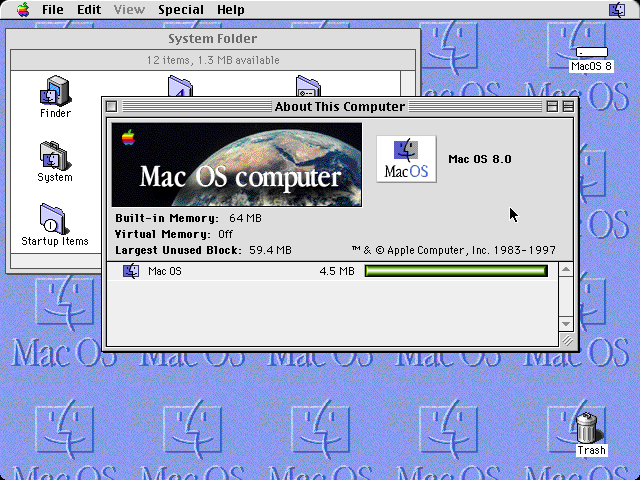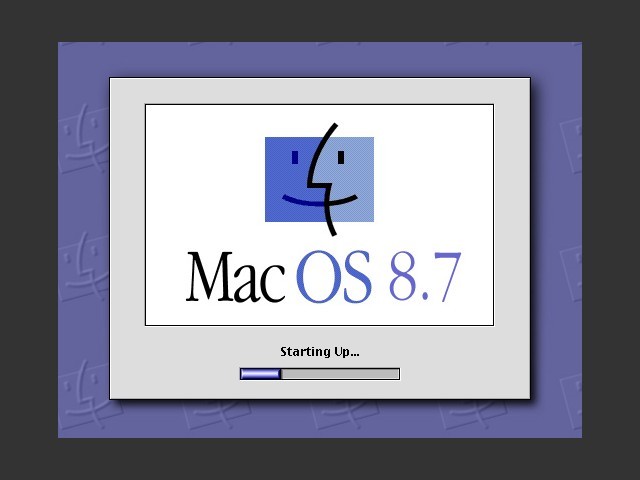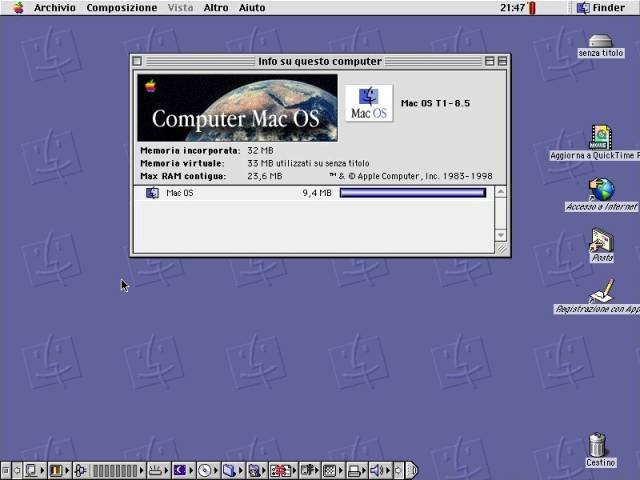- Mac Open Firmware
- Mac Open Firmware Commands
- Open Firmware Commands
- Mac Os 8.6 Open Firmware User Manual Quotes Digital Download
MacOS signaled the first real attempts to turn the company around with their new Rhapsody / OS X OS behind the scenes, and finally updating the ancient OS 7. Many pirates of the era refused to carry OS 8, or anything else Apple related, to get people to encourage people to instead buy the software as the company was in dire straights. 1999 - Mac OS 8.6, multi-processor capable 1999 - Mac OS 9 (sonata), Sherlock 2 can handle files with size up to 2 tbyte, user profiles (multiple users) 2001 - Mac OS 9.1 1999 - Mac OS X Server, Mach- Kernel 2.5 (Unix-derivated microkernel) better performance and stability 1999 March - Mac OS X Server 1.0 2000 - Mac OS X Server 1.2.3.
What's New in Mac OS 8.6 Update and CD-ROM
This document provides information about Mac OS 8.6 that supplements the information in your installation manual, on-line help, and About Mac OS 8.5 Readme. For up-to-date news and compatibility information, please see the Mac OS Late-Breaking News web site at <www.info.apple.com/latebreakingtips>
Notes about Mac OS 8.6

After performing a clean install of Mac OS 8.6, your monitor resolution may have changed from its previous settings. You can change your monitor resolution back by using the Monitors & Sound control panel.
If a desktop picture is redrawn slowly after closing a window, your computer might be running low on memory. Set the Appearance control panel to display a pattern, instead of a picture, to speed up the redrawing process.

Some applications may exhibit unusual or inconsistent cosmetic anomalies when used with Mac OS 8.6. These should not impact the performance of the application. Contact the manufacturer of the program to see if an updated version of the program is available.
If you are using an iMac or a 'blue and white' Power Macintosh G3 computer, do not attempt to move the file 'Mac OS ROM' from a Mac OS 8.6 system software folder into a previous system software folder. This may result in a system folder which will not start your computer. Always use the Mac OS 8.6 installer when upgrading these computers to Mac OS 8.6.
The Mac OS 8.6 default installation places newer versions of certain files on the NetBoot HD disk image, but does not remove the older versions which are on the Applications HD disk image. After installing Mac OS 8.6, you need to move the newer versions from the NetBoot HD to the Applications HD, and delete the older versions.
Notes about compatibility
ColorSync 2.6 now includes support for Unicode tags inside of ColorSync/ICC Profiles. Some profiles may not show up under the ColorSync Control Panel after version 2.6 or later is installed. Apple is working on a utility to help update profiles to support this. Visit the web site at: <www.apple.com/colorsync> for more information.
When trying to dial in to a Compuserve account from the Remote Access control panel, after entering the password wait until the server responds before you press continue.
Mac OS 8.6 does not support start-up volumes based on DVD-RAM media. If you install Mac OS 8.6 on a DVD-RAM volume you will not be able to boot your Macintosh from that volume.
Newer versions of the Apple Multiple Scan 15 will not support 512x384 resolution. The Mac OS will notify you when your monitor does not support a particular resolution.
The File Synchronisation control panel may crash if any of the folders or volumes in the window have a custom icon. You can remove a custom icon from a folder or volume by selecting it, Get Info on it (Command-I), select the icon in the upper left hand corner, and type Command-X.
After you install Mac OS 8.6, you cannot use the obsolete Apple HD SC Setup program to initialise your Apple hard drive. Use the Drive Setup program supplied with Mac OS 8.6 instead.
Some applications replace the version of QuickTime installed by Mac OS 8.6 with an earlier version when they are installed. This will cause problems with other parts of the system that require features of the newer version of QuickTime. If this occurs, you will need to re-install QuickTime from the Mac OS 8.6 CD by selecting 'Add/Replace' in the installer, and then doing a custom install.
Connectix Virtual PC 2.1.1 and earlier (including version 1.X) are not compatible with Mac OS 8.6 and users should update to version 2.1.2 or later. The 2.1.2 updater is available as a free download for all Virtual PC 2.0 owners on the Connectix web site: <http://www.connectix.com/html/updates.html>
The Desktop Printing extension is incompatible with Mac OS 8.6. It may cause your computer to freeze when starting up. Restart with the shift key held down and remove the file from the Extensions folder, then restart.
Dr. Solomon's Virex versions 5.9 and earlier are not compatible with Mac OS 8.6 if the Virex 'Scan Files When Opened' option is turned on. For more information on upgrading to Virex 5.9.1, contact Dr. Solomon's software at virex-tech@drsolomon.com or <http://www.drsolomon.com.>
Mac OS 8.6 includes support for the use of removable media (like the Iomega Jaz drive) for Virtual Memory.

If you wish to install Mac OS 8.6 onto a Zip or Jaz disk, you should change the backing volume used by Virtual Memory to a non—removable volume. To do this, disable extensions while restarting the first time by holding down the shift key. Open the Memory control panel and turn on Virtual Memory. The Memory control panel will let you set the VM backing volume to a volume that is compatible with VM.
On some Powerbook models, mounted Zip disks won't show up as mounted in the Media Bay Control Strip module but they are mounted and will appear on the desktop.
Some programs may require Additional MemorySome programs may require additional memory when used with Mac OS 8.6. If a program will not open, select the program's icon, choose Get Info from the File menu and increase its minimum memory allocation by 300K. See the Memory topic in Mac OS Help for more information.
Notes about Printing
If you perform a clean installation of Mac OS 8.6, and an icon for your printer is not available in the Chooser, you may need to re-install the software that came with your printer.
If you have a StyleWriter, StyleWriter II, or StyleWriter 1200, you should use the StyleWriter 1500 driver that comes with Mac OS 8.6 instead of installing your original printer software. If you have a Colour StyleWriter 2200 or Colour StyleWriter 2400, you should use the Colour StyleWriter 2500 driver instead. After performing a clean install of Mac OS 8.6, you may need to re-install fonts that came with your printer software.
If you use a Colour StyleWriter 4000 Series printer and have performed a clean install of Mac OS 8.6, you must custom install your printer driver.
LaserWriter 8.6.5 and USB printersLaserWriter 8.6.5 adds support for printing to USB-compatible PostScript printers, but additional hardware may be required to connect your printer to the USB port of your computer. Contact your printer manufacturer to determine the USB compatibility of your printer.
Miscellaneous notes
Mac OS 8.6 includes a new version of the QuickTime PowerPlug for computers with PowerPC microprocessors. The QuickTake 150 Installer replaces it with an older version (version 2.0). To install the QuickTake 150 software, first remove the newer version of the QuickTime PowerPlug extension from the Extensions folder (within the System Folder) then install the QuickTake 150 software. After installation is finished, drag the PowerPlug file back to the Extensions folder replacing the older one.
When you are copying pictures from a QuickTake 100 or QuickTake 150 camera to your computer, make sure all the pictures you want have finished copying before you erase the contents of the camera. Previously, you couldn't erase the camera until copying was completed. Mac OS 8.6 can perform other tasks while copying files so it's possible to accidentally erase the pictures before they have been copied from the camera. You cannot recover a picture once it is erased from the camera.
Some of the manuals included with Mac OS 8.6 are in Adobe Acrobat format. These files have 'pdf' at the end of their names. To view or print these documents you must install Adobe Acrobat Reader, located in the Adobe software folder on the Mac OS 8.6 CD.
Mac Open Firmware
If your iMac does not have infrared hardware, you will get an error when launching the infrared Control Panel.© 1999 Apple Computer, Inc. All rights reserved. Apple, the Apple logo, AppleShare, Apple Script, AppleTalk, Chicago, LaserWriter, LocalTalk, Macintosh, Mac OS, Power Macintosh, PowerBook, QuickDraw, QuickTake, QuickTime, and StyleWriter are trademarks of Apple Computer, Inc., registered in the U.S. and other countries. At Ease, Disk First Aid, and Finder are trademarks of Apple Computer, Inc. Adobe and Adobe Acrobat are trademarks of Adobe Systems, Incorporated or its subsidiaries and may be registered in certain jurisdictions. PowerPC is a registered trademark of International Business Machines Corporation, used under license therefrom.
Updated April 6, 1999
Microsoft's Windows and Apple's Mac operating systems have inspired truly prodigious amounts of adulation and horror on the part of computer users for about three decades now.
Those of us who love technology aren't likely to forget our first desktop operating systems. But the OSes of yore don't have to live only in your memories. While it might be difficult to fire up the first PCs you ever owned today, some computer enthusiasts have made it easy for us to relive what it was like to use them again with almost no effort at all.
If you want to be able to use all the features of an old operating system, you'll probably have to find the software and load it in a virtual machine. But there are a bunch of browser-based emulators that show you what the old OSes looked like and let you click on a few things. It's a lot easier, and it may satisfy your urge to relive the past. Here are a few such websites to fuel your technostalgia.
Windows 1.0: It’s older than the World Wide Web
It's the very first version of the most widely used desktop operating system in history, released in 1985. I went to a lot of trouble to run Windows 1.0 in a virtual machine on a Windows 7 PC a few years ago, but you can live in the past right now by clicking on jsmachines.net, short for 'JavaScript Machines.'
The emulator is in black and white rather than color, and you can't save any changes, but you can use the mouse cursor and run the earliest Windows programs, like Reversi, Notepad, and Paint:
AdvertisementThe simulation is 'configured for a clock speed of 4.77Mhz, with 256Kb of RAM and a CGA display, using the original IBM PC Model 5160 ROM BIOS and CGA font ROM,' the website notes. 'This PC XT configuration also includes a 10Mb hard disk with Windows 1.01 pre-installed.'
Mac OS System 7 on a virtual Mac Plus
This website lets you run Mac OS System 7, released in 1991, on a simulated Macintosh Plus, a computer introduced in 1986. As a nice touch, it runs the OS within an illustration of the physical computer:
Developer James Friend writes that this demo 'emulates a Mac Plus with a bunch of abandonware applications and games to check out.' The website is a bit sluggish and difficult to use, but it's fun to look at.
Mac Open Firmware Commands

Windows 3.1: Windows gets a lot more window-y
Coder Michael Vincent's website provides a functional version of Windows 3.1 from 1992, which he says he made in 'JavaScript and strict XHTML 1.0, with AJAX functionality provided through PHP.' Vincent recommends using Firefox 2 or 3, but it worked fine for me in Chrome 33 and Firefox 26.
'The goal of this site is not to create an entirely complete mirror image of Windows 3.1, but rather keep the spirit and omit features when they are not justified by an effort to usability ratio,' he writes. 'For example, Notepad lacks a find and replace feature because it is not worth the effort. Where features do exist, every effort is made to present them in exactly the manner that they existed in Windows 3.1.'
This is one of the more functional browser-based emulators. You can use applications, open files, and even surf the 2014 Web on a browser (apparently one Vincent designed himself):
Mac OS 8.6: The classic Mac OS nears the end of its life
Released in 1999 and one of the last versions of the classic Mac operating system before it was replaced by OS X, you can find this old operating system at VirtualDesktop.org.
This one isn't totally usable. I couldn't resize or move windows, and not all of the icons are clickable. But the included functions work smoothly, and you can open enough applications and menus that it provides a nice look at a long-gone OS.
AdvertisementWindows 95: Start it up!
VirtualDesktop.org offers a bunch of other versions of Windows and Mac, including one of the most fondly remembered operating systems, Windows 95. This one also isn't totally functional, but it's worth firing up to see the first version of Microsoft's iconic Start menu:
Just for kicks, here's one other 'fully functional' version of Windows 95 that may provide you with a frustratingly familiar sight.
OS X 10.2: The classic Mac OS is retired
VirtualDesktop.org also comes through with one of the earliest versions of OS X, Jaguar. You can navigate through some of the system preferences, see an early version of the OS X dock, and start up Mail or Internet Explorer for Mac. Once again, if you want a fully functional version, you'll probably have to install a copy on a virtual machine.
Windows XP: A classic that’s regrettably still with us
We'll finish off with the operating system that just won't die no matter how old it is. Released in 2001, Windows XP still commands 29 percent market share, making it the second most widely used OS after Windows 7.
Open Firmware Commands
Our XP simulation comes courtesy of Total Emulator, a neat little website that isn't pretty but makes it easy to switch among Windows ME, 98, 2000, XP, and Vista:
Mac Os 8.6 Open Firmware User Manual Quotes Digital Download
So ends our nostalgia
That ends our brief tour of old Windows and Mac versions you can run in a browser. Sadly, as far as we can tell, no developers have made websites that emulate BeOS or OS/2, classic operating systems that went by the wayside. Any volunteers?